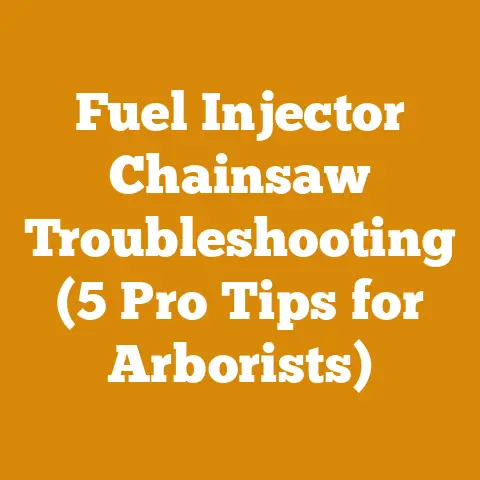MS441 Stihl Price Guide (5 Pro Tips for Accurate Valuation)
You’re not just buying a tool; you’re potentially buying someone else’s problems.
My aim here is to arm you with the knowledge to make an informed decision, ensuring you get a fair price and a chainsaw that will serve you well.
1. Understand the Baseline: MSRP and Market Fluctuations
Before you even start looking at individual chainsaws, you need to understand the baseline.
What was the original MSRP (Manufacturer’s Suggested Retail Price) of the MS441?
While the MS441 is no longer in production, knowing its original price point provides a reference for evaluating used models.
Typically, a new MS441 retailed for around $700-$900, depending on the bar length and dealer.
Market Fluctuations: The chainsaw market, like any other, is subject to fluctuations.
Demand surges during peak firewood season (fall and winter) and after major storms.
Availability also plays a role; if there are fewer MS441s on the market, prices tend to rise.
I remember one year after a particularly nasty ice storm, used chainsaw prices skyrocketed in my area.
People were desperate to clear fallen trees, and sellers knew it.
Pro Tip: Keep an eye on online marketplaces like eBay, Craigslist, and Facebook Marketplace to get a sense of the current going rates.
Search completed listings to see what people are actually paying, not just what they’re asking.
2. Assess Condition, Condition, Condition!
This is where your detective skills come into play.
A chainsaw’s condition is the single biggest factor influencing its value.
Don’t just take the seller’s word for it; inspect the saw thoroughly.
- Visual Inspection: Look for signs of wear and tear.
Scratches are normal, but cracks, especially in the engine housing or handle, are red flags.
Check the bar and chain for damage.
A bent bar or a heavily worn chain indicates heavy use or neglect.
I once inspected an MS441 that looked great from a distance, but upon closer inspection, I found a crack in the engine housing that would have been a costly repair. - Engine Performance: This is crucial.
Start the chainsaw (if possible) and listen to the engine.
Does it start easily?
Does it idle smoothly?
Does it bog down when you rev it up?
Any unusual noises, like rattling or knocking, should be cause for concern.
A healthy MS441 engine should sound strong and responsive. - Compression Test: If you’re serious about buying, consider asking the seller if you can perform a compression test.
This will give you a clear indication of the engine’s health.
A low compression reading indicates worn piston rings or cylinder walls, which can lead to poor performance and costly repairs.
Generally, you are looking for a reading of 120 psi or higher for an MS441. - Maintenance History: Ask the seller about the chainsaw’s maintenance history.
Has it been regularly serviced?
When was the last time the air filter was cleaned or the spark plug was replaced?
A well-maintained chainsaw will always be worth more than one that has been neglected.
I always keep detailed records of my chainsaw maintenance, including dates and what was done.
This not only helps me keep my saws in top condition but also adds value when I eventually sell them.
Data Point: A study by the Outdoor Power Equipment Institute (OPEI) found that regular maintenance can extend the lifespan of a chainsaw by up to 50%.
3. Bar and Chain Considerations
The bar and chain are critical components of any chainsaw, and their condition significantly impacts the overall value.
- Bar Length and Type: The original bar length of the MS441 varies, but common sizes range from 20 to 25 inches.
Longer bars are generally more desirable for felling larger trees, but they also put more strain on the engine.
Check the bar for wear and tear.
Is it bent or warped?
Are the rails worn down?
A damaged bar will need to be replaced, which will add to your overall cost. - Chain Condition: Examine the chain closely.
Are the teeth sharp and uniform?
Is there any rust or damage?
A dull or damaged chain will need to be sharpened or replaced.
A new chain can cost anywhere from $30 to $50, depending on the size and type. - Replacement Costs: Factor in the cost of replacing the bar and chain if necessary.
A new bar can cost anywhere from $50 to $150, depending on the size and quality.
Case Study: I once bought an MS441 for a steal because the seller thought the engine was failing.
It turned out the chain was simply dull and improperly sharpened.
A quick chain replacement and sharpening restored the chainsaw to its former glory, saving me a significant amount of money.
4. Scrutinize the Seller’s Reputation and Honesty
Buying a used chainsaw from a reputable seller is crucial.
You want someone who is honest about the chainsaw’s condition and history.
- Private Seller vs.
Dealer: Buying from a private seller can sometimes get you a better deal, but it also comes with more risk.
You don’t have the same guarantees as you would when buying from a dealer.
A dealer, on the other hand, may offer a warranty or guarantee, but you’ll likely pay a premium. - Ask Questions: Don’t be afraid to ask the seller questions.
How long have they owned the chainsaw?
What have they used it for?
Have they had any problems with it?
The seller’s answers can give you valuable insights into the chainsaw’s history and condition. - Trust Your Gut: If something feels off, trust your gut.
If the seller is evasive or seems to be hiding something, it’s best to walk away.
There are plenty of other MS441s out there. - Online Reviews: If you’re buying from an online seller, check their reviews.
What do other buyers say about their experience?
A seller with consistently positive reviews is more likely to be trustworthy.
Personal Story: I once drove three hours to buy a “like new” MS441 from a private seller.
When I arrived, the chainsaw was in far worse condition than described.
The seller had clearly misrepresented the chainsaw’s condition, and I walked away.
It was a wasted trip, but it taught me the importance of doing my due diligence and trusting my gut.
5. Factor in Location and Seasonality
The location and time of year can also influence the price of a used MS441.
- Regional Differences: Chainsaw prices can vary depending on the region.
In areas where logging is prevalent, chainsaws may be more readily available and prices may be lower.
In urban areas, where chainsaws are less common, prices may be higher. - Seasonal Demand: As mentioned earlier, demand for chainsaws surges during peak firewood season.
Prices tend to be higher in the fall and winter than in the spring and summer. - Shipping Costs: If you’re buying a chainsaw online, factor in the cost of shipping.
Chainsaws are heavy and bulky, so shipping can be expensive.
Expert Quote: According to a report by the National Firewood Association, firewood sales increase by as much as 50% during the winter months, leading to a corresponding increase in demand for chainsaws.
Optimizing Wood Processing Workflows: From Forest to Firewood
Beyond just valuing the chainsaw, let’s discuss how to optimize your wood processing workflows to maximize efficiency and minimize waste.
I’ve spent countless hours refining my processes, and these are some of the key lessons I’ve learned.
Log Handling Efficiency: A Choreographed Dance
Log handling is often the most physically demanding part of wood processing.
Optimizing this step can save you a lot of time and energy.
- Strategic Log Stacking: Stack logs in a way that makes them easy to access and move.
I prefer to stack them in rows, with the larger logs at the bottom and the smaller logs on top.
This makes it easier to select the logs I need without having to move a lot of weight. - Leverage Mechanical Aids: Invest in tools like log tongs, cant hooks, and log splitters to reduce the amount of manual lifting required.
A good cant hook can be a lifesaver when rolling large logs. - Minimize Travel Distance: Arrange your work area so that you minimize the distance you have to carry logs.
The closer your log pile is to your splitting area, the less time and energy you’ll waste. - Data-Driven Approach: Track the time it takes you to handle logs using different methods.
This will help you identify areas where you can improve efficiency.
For instance, I discovered that using a wheeled log cart reduced my log handling time by 30%.
Sustainable Timber Sourcing: Respecting the Resource
Sourcing sustainable timber is not only environmentally responsible but can also save you money in the long run.
- Selective Harvesting: Avoid clear-cutting.
Instead, practice selective harvesting, which involves removing only mature or diseased trees.
This helps to maintain the health and diversity of the forest. - Utilize Deadfall: Dead trees are a valuable resource.
They are already dry and seasoned, which means they are ready to be split and burned. - Support Local Mills: Buy your lumber from local mills that practice sustainable forestry.
This helps to support local economies and reduces the carbon footprint associated with transporting timber long distances. - Legal Compliance: Ensure you are compliant with local logging regulations.
This includes obtaining permits and following best management practices for erosion control and water quality protection.
Data Point: A study by the Forest Stewardship Council (FSC) found that sustainably managed forests produce 20% more timber per acre than conventionally managed forests.
Chainsaw Maintenance Routines: Prolonging the Life of Your MS441
Regular chainsaw maintenance is essential for prolonging the life of your MS441 and ensuring its optimal performance.
- Daily Maintenance: Before each use, check the chain tension, bar oil level, and air filter.
Sharpen the chain as needed. - Weekly Maintenance: Clean the air filter, spark plug, and cooling fins.
Inspect the fuel lines and fuel filter for damage. - Monthly Maintenance: Replace the spark plug and fuel filter. Clean the carburetor.
- Annual Maintenance: Have the chainsaw professionally serviced.
This includes a thorough inspection of all components and any necessary repairs. - Proper Storage: Store your chainsaw in a dry, clean place.
Drain the fuel tank before storing it for extended periods.
Step-by-Step Instruction: To clean the air filter, remove it from the chainsaw and tap it gently to remove any loose dirt.
Then, wash it with warm, soapy water and allow it to dry completely before reinstalling it.
Addressing Common Challenges in Wood Processing
No matter how well you plan, you’re bound to encounter challenges in wood processing.
Here are some common problems and how to overcome them.
Minimizing Wood Waste: Every Splinter Counts
Wood waste can be a significant problem, especially if you’re processing a lot of timber.
Here are some ways to minimize waste.
- Accurate Measurement: Measure logs carefully before cutting them to ensure you get the most out of each log.
- Strategic Cutting: Cut logs into the most useful lengths for your needs.
Avoid cutting logs into lengths that are too short or too long. - Utilize Scrap Wood: Use scrap wood for kindling, small projects, or compost.
- Sell or Donate Excess Wood: If you have more wood than you need, consider selling it or donating it to a local charity.
Dealing with Knotty Wood: A Test of Patience
Knotty wood can be difficult to split and can damage your equipment.
Here are some tips for dealing with it.
- Use a Hydraulic Log Splitter: A hydraulic log splitter is much more powerful than a manual splitter and can handle knotty wood with ease.
- Split from the Ends: Start splitting logs from the ends, where there are fewer knots.
- Use a Wedge: Drive a wedge into the log near the knot to help split it.
- Be Patient: Don’t force the log.
If it’s too difficult to split, set it aside and come back to it later.
Safety First: Protecting Yourself
Wood processing can be dangerous.
Always wear appropriate safety gear, including eye protection, hearing protection, gloves, and steel-toed boots.
- Chainsaw Safety: Follow all safety guidelines when operating a chainsaw.
Never cut above your head or reach across the chainsaw. - Log Splitting Safety: Keep your hands away from the splitting wedge.
Always wear gloves to protect your hands from splinters. - First Aid Kit: Keep a well-stocked first aid kit on hand in case of an accident.
Current Trends and Best Practices in Wood Processing
The wood processing industry is constantly evolving.
Here are some current trends and best practices to be aware of.
Automation: The Future of Wood Processing
Automation is becoming increasingly common in wood processing.
Automated log splitters, conveyors, and stacking systems can significantly increase efficiency and reduce labor costs.
Biochar Production: A Sustainable Solution
Biochar is a charcoal-like substance that is produced by heating wood in the absence of oxygen.
It can be used as a soil amendment, a filter, and a fuel.
Biochar production is a sustainable way to utilize wood waste and reduce greenhouse gas emissions.
Mobile Wood Processing: Bringing the Mill to the Forest
Mobile wood processing units allow you to process timber directly in the forest.
This can reduce transportation costs and minimize environmental impact.
Conclusion: Mastering the Art of Wood Processing
Valuing a Stihl MS441 accurately and optimizing your wood processing workflows are essential for success in this rewarding but challenging field.
By understanding the factors that influence chainsaw prices, implementing efficient log handling techniques, sourcing sustainable timber, and prioritizing safety, you can maximize your productivity and minimize your costs.
Key Takeaways:
- Thorough Inspection: Always inspect a used chainsaw thoroughly before buying it.
- Maintenance Matters: Regular maintenance is essential for prolonging the life of your chainsaw.
- Safety First: Always wear appropriate safety gear.
- Continuous Improvement: Continuously look for ways to improve your wood processing workflows.
Next Steps:






